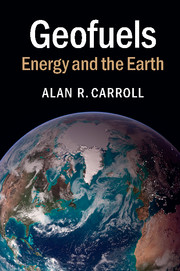Book contents
- Frontmatter
- Contents
- Acknowledgments
- 1 Introduction
- 2 The Living Earth
- 3 Warmed from Above: Solar Energy
- 4 Wind, Water, and Waves: Energy from the Fluid Earth
- 5 Covered in Green: Biofuels Basics
- 6 Fossil Farming: The Geologic Underpinnings of Biofuels
- 7 The Light of an Ancient Sun: Fossil Fuel Origins
- 8 Digging for Daylight: Coal and Oil Shale
- 9 Skimming the Cream: Conventional Oil and Gas
- 10 Stuck in the Mud: Fossil Fuels That Fail to Flow
- 11 Petrified Petroleum: Oil Sand and Gas Hydrate
- 12 Water, Water, Everywhere
- 13 Primordial Power: Geothermal and Nuclear
- 14 Out of Sight, Out of Mind: Geologic Waste Disposal
- 15 How Long Is Forever? Energy and Time
- 16 Conclusions
- Index
- References
2 - The Living Earth
Published online by Cambridge University Press: 05 March 2015
- Frontmatter
- Contents
- Acknowledgments
- 1 Introduction
- 2 The Living Earth
- 3 Warmed from Above: Solar Energy
- 4 Wind, Water, and Waves: Energy from the Fluid Earth
- 5 Covered in Green: Biofuels Basics
- 6 Fossil Farming: The Geologic Underpinnings of Biofuels
- 7 The Light of an Ancient Sun: Fossil Fuel Origins
- 8 Digging for Daylight: Coal and Oil Shale
- 9 Skimming the Cream: Conventional Oil and Gas
- 10 Stuck in the Mud: Fossil Fuels That Fail to Flow
- 11 Petrified Petroleum: Oil Sand and Gas Hydrate
- 12 Water, Water, Everywhere
- 13 Primordial Power: Geothermal and Nuclear
- 14 Out of Sight, Out of Mind: Geologic Waste Disposal
- 15 How Long Is Forever? Energy and Time
- 16 Conclusions
- Index
- References
Summary
The result, therefore, of our present enquiry is, that we find no vestige of a beginning – no prospect of an end.
James Hutton, 1788As planets go, the Earth is a party animal. Its continents wander endlessly, sometimes clustering together in temporary cliques, other times splitting up and disbanding. Their surfaces may plunge 10 km down or more, buried beneath thick blankets of sediment, or sky-rocket 8 km upward, shaking violently the whole while. Fireworks are on perpetual display in the form of volcanoes, which emit anything from ropy lava flows to giant dust clouds that blot out the Sun. Glacial ice appears, disappears, and returns again with alarming speed and frequency. The sea rolls relentlessly in and out, creating beachfront property in St. Louis or land bridges from Alaska to Asia.
So why don't we notice? Sometimes we do, particularly during major earthquakes and volcanic eruptions. Generally though we experience an illusion of stability, because we are relatively short-lived animals inhabiting a very long-lived planet. Most of the action happens too slowly for us to perceive directly. To get a better sense of the vast discrepancy between geologic and human timescales, it helps to compare the history of the Earth to a single calendar year. Marked on January 1 of this calendar is the notation “Earth condenses from the presolar nebula”. The earliest life-forms appear sometime in late March, but complex animals do not evolve until November 11. The dinosaurs appear on December 10 and disappear the day after Christmas. Modern humans (Homo sapiens) show up on New Year's Eve and are quite late to the party, arriving only twelve minutes before midnight. The entire 20th century is encompassed in the last tick of the second hand before midnight.
The Birth of the Earth
The Earth originally condensed about 4.55 billion years ago, a time so distant that even the Earth itself can't easily recall the details. No intact rocks from the Earth's first ∼500 million years have been found, leaving a substantial gap in the early record of the planet's evolution.
- Type
- Chapter
- Information
- GeofuelsEnergy and the Earth, pp. 13 - 31Publisher: Cambridge University PressPrint publication year: 2015



